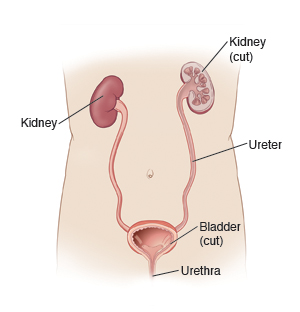Blood in the urine (hematuria) has many possible causes.
Common causes of blood in the urine include urinary tract infections, kidney stones, inflammation, tumors, or certain other diseases of the kidney or bladder.
If it occurs after an injury (such as a car accident or fall), it's most often a sign of bruising to the kidney or bladder.
Menstruation can cause blood to appear in a urine sample, but it's not coming from the urinary tract.
If only a tiny (trace) amount of blood is present, it will show up on the urine test, even though the urine may be yellow and not pink or red. This may occur with any of the above conditions, as well as heavy exercise or high fever. In this case, your health care provider may want to repeat the urine test on another day. This will show if there's still blood in the urine. If there is, then other tests can be done to find the cause.
Home care
Treatment is aimed at the specific underlying cause. Some causes of blood in urine don’t need any treatment.
Follow these home care guidelines:
-
If your urine doesn't look bloody (pink, brown, or red) then you typically don't need to restrict your activity in any way.
-
If you can see blood in your urine, rest and don't do any strenuous activity until your next exam. Don't use aspirin, blood thinners, or antiplatelet or anti-inflammatory medicines without your provider's approval. These include ibuprofen and naproxen. They thin the blood and may increase bleeding. Call your provider to talk about using these medicines.
Follow-up care
Follow up with your provider as advised. If you were injured and had blood in your urine, you should have a repeat urine test in 1 to 2 days. Contact your provider for this test.
A radiologist will review any X-rays that were taken. You'll be told of any new findings that may affect your care.
When to contact your doctor
Contact your provider right away if:
-
Bright red blood or blood clots appear in your urine (if you didn't have this before).
-
You feel weak, dizzy, or faint.
-
You have new groin, belly, or back pain.
-
You have a fever of 100.4ºF (38ºC) or higher, or as advised by your provider.
-
You have repeated vomiting.
-
You have bleeding from the nose or gums, or are bruising easily.


